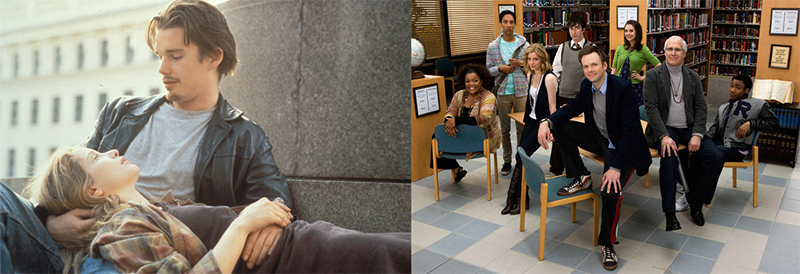Listen, I don’t know where I’m going with this but I want to noodle about something you. It does slightly concern a TV show that remains a favourite of mine despite tailing off. It also concerns a film that will always be a favourite, no tailing off possible.
So, here’s the thing. In the very closing moments of the film Before Sunrise, we get a series of daytime shots of various locations around Vienna. They’re the same ones that we have just spent the film seeing but during most of the film we saw them at night and always, always with Celine and Jesse in them.
Usually talking.
It’s a quiet yet startling ending that I think speaks to how much we create within spaces: the locations are the same but without the characters they are different. Because they’re now in daytime it’s like the lights being switched on, the reality of the stage revealed. It’s reminded me of parties where really no matter what you do setting one up, success or failure is really down to who comes and what they’re like when they do. The party is an excuse for people, locations are a canvas for characters.
I think about this more than honestly seems feasible but I was minded of it particularly this week by the last episode of Community. It’s been a weak season and I don’t know if it is the last-ever episode but it probably is and there was something of that Before Sunrise feel to it.
Specifically the episode did show us some of the regular sets now empty of people and it had that same canvassy feel for me.
It seemed to be saying both that we’re done here – and look at what we did.
Six years ago this was a study room in a library and these were the characters we didn’t yet know. Now the same room is the site of epic paintball battles, the table is a replacement replica because they destroyed the first one with an axe. It’s like those stories are still in the room, even though really they’re still in our heads if we’ve seen them. I want to think that you sense them whether you know the show or not.
I’ve often thought of it the other way around, of looking ahead to what potential a set has.
I love that television series have specific recurring sets for basically economic reasons yet they become dramatic ones. It’s cheaper to film on the same set each week and even if you have the budget to be on location all the time, you need somewhere indoors to shoot when the weather is bad. But you also get what used to be called the familiar locale, a place for viewers to want to go to. These days it’s called the show’s precinct, presumably after all the cop shows that were set in actual precincts, but the principle of it being somewhere familiar persists.
The famous example is in Star Trek where in theory we all aspired to be on the Enterprise. Certainly the Coronation Street tours exist on the fact that people want to visit Weatherfield. When I first heard of the Harry Potter studio tours I couldn’t get it: it’s just a set, why do you want to visit a set?
But then I was thrilled being shown around the sets of new Crossroads Hotel back when I got to write for that series. I liked seeing the replica TARDIS sets in the Doctor Who Experience.
Place matters. I think it matters most in television.
Films can go anywhere and despite all the sequels we get now, it’s still generally following recurring characters more than recurring locations. Radio can go anywhere though Ambridge feels real to listeners now. Theatre will often establish a specific place but it doesn’t feel like something we return to, it’s a frame for this specific play this specific evening.
In television I think places become characters. The Enterprise was often called that by the writers. I just rewatched Studio 60 on the Sunset Strip and while it’s irritatingly flawed, one thing that is exceptional is the massive set. It’s a completely constructed theatre studio that creates a complete world yet allows for every possible combination of big and intimate scenes, large groups and pairs of people. Also huge movement: the set constrained characters and it let them loose too.
The set has the last word in Studio 60 too. The final shot is of someone switching off a lone lightbulb. It’s never been there before, it exists only to be switched off, it is visual reference to the end of a play, it is in all ways contrived. But it works: I forget the character problems, the creepy romance, the unfunny comedy sketches and instead I’m left wishing we could stay in that set, in that world for longer.
Dammit. The hardest thing in drama is creating a character. Then you have to create another one for them to talk with. Now we have to create somewhere for them to go too?
